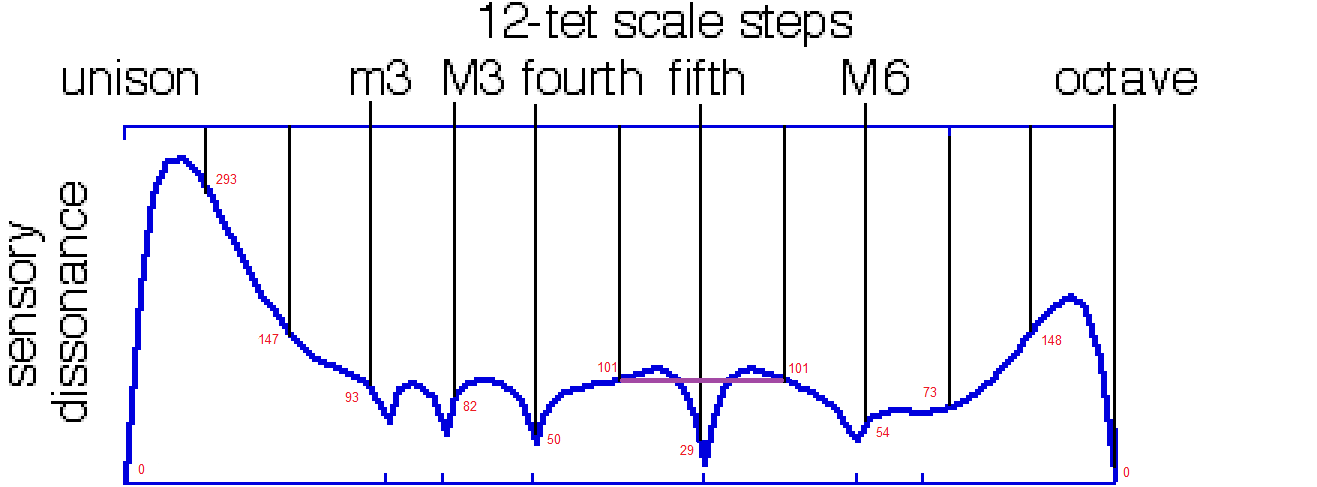So for months now I'm becoming increasingly frustrated with this Just Intonation versus Equal Temperament, so maybe with this question we can nip it in the bud. If we could refrain from "complex mathematics" which i have trouble comprehending and utilize language and simple math, it would be most efficient.
I will firstly articulate my goal behind asking this question..
I have produced with the help of you good people an interval ranking. The purpose of this interval ranking is solely to tell me what intervals within an octave are most consonant to dissonant from most to least.
The reason i sought this information is so that i can build a chord with the exact desired level of consonance and/or dissonance that i preferred so that when i build a chord progression, i have entire mathematical control over the result. Wrong or right, this is my absolute goal.
The very specific question follows..
If i am using the interval ranking chart for the stated above purpose, does this ranking of intervals from most consonant to dissonant apply to composition in 12tet or when composing in 12tet do the degrees of consonance and dissonance of intervals in just intonation differ in 12tet. I do not mean in their numerical properties but their general sonic properties.
Alternatives..
If this is not the case..
- How can i translate the interval ranking from Just Intonation to 12tet, so that i have a list of intervals from most consonant to dissonant applicable to 12tet?
The desired end result of this question example..
- Unison = 1st most consonant interval in an octave.
- Octave = 2nd most consonant interval in an octave.
- Perfect Fifth = 3rd most consonant interval in an octave.
- Perfect Fourth = 4th most consonant interval in an octave.
- Major Sixth = 5th most consonant interval in an octave.
- Major Third = 6th most consonant interval in an octave.
- Minor Third = 7th most consonant interval in an octave.
- Minor Sixth = 8th most consonant interval in an octave.
- Minor Seventh = 9th most consonant interval in an octave.
- Major Second = 10th most consonant interval in an octave.
- Major Seventh = 11th most consonant interval in an octave.
- Minor Second = 12th most consonant interval in an octave.
- Tritone = 13th most consonant interval in an octave.
I mean this in the most polite manner possible, i am looking for a very straight cut answer. I do not require complex mathematics or incredibly detailed answers. I am just seeking to have a list of intervals within an octave from most consonant to least consonant applicable to 12tet composition. Ideally the desired end result of this question i displayed would be the perfect format to answer this question.
Tremendous thanks to you.
EDIT!!
There seems to be quite a few comments stating that it is impossible to rank 12 intervals in an octave by most consonant to dissonant so let me elaborate.
If a chord progression is developed through tension and release, that tension and release is accounted for by a combination of intervals (a chord) that through each bar go from dissonant (tension) to consonance (rest). If we acknowledge that a chord could be considered to be multiple intervals at work simultaneously, how can we absolutely deny their individual degrees of consonance and dissonance within context of a chord progression? The denial is absolutely baffling to me. It is obvious that the interval of a perfect fifth is more consonant than the interval of a minor second, so evidently the intervals do have their individual degree of consonance/dissonance relative to the root. I will even assume that maybe some of you good folks are jumping in the gun in your answers as opposed to what im specifically asking which revolves around interval to interval relationship and not for example a chord progression. I am not asking how this method would be applicable to a progression, i am very specifically asking what intervals are most consonant to dissonant relative to the root (interval) in 12tet. Nothing more and nothing less.
I also saw a comment stating "what may sound consonant to one listener may be dissonant to another". I think it is undeniable that any listener on planet earth would find an octave more dissonant than a minor second. So evidently a consonance/dissonance ranking does exist and i will paste below my actual ranking which i think some confused my example one for a real ranking.
My question is, is the ranking below applicable to 12tet, not by its numerical values which i understand differ slightly, but the general sound.
I hope this helps.
- Unison = 1:1 Perfect Consonance (1st note of an octave)
- Octave = 2:1 Perfect Consonance (13th note of an octave)
- Perfect Fifth = 3:2 Perfect Consonance (8th note of an octave)
- Perfect Fourth = 4:3 Dissonant when the bass note (6th note of an octave)
- Major Sixth = 5:3 Imperfect Consonance (10th note of an octave)
- Major Third = 5:4 Imperfect Consonance (5th note of an octave)
- Minor Third = 6:5 Impefect Consonance (4th note of an octave)
- Minor Sixth = 8:5 Imperfect Consonance (9th note of an octave)
- Minor Seventh = 9:5 Dissonant (11th note of an octave)
- Major Second = 9:8 Dissonant (3rd note of an octave)
- Major Seventh = 15:8 Dissonant (12th note of an octave)
- Minor Second = 16:15 Dissonant (2nd note of an octave)
- Tritone = 7:5 Dissonant (7th note of an octave)

